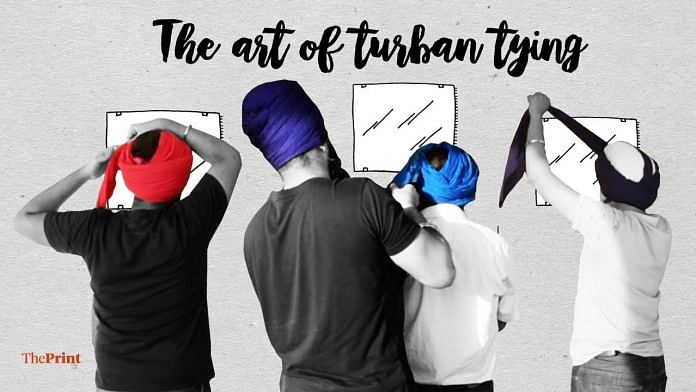The Sikh tradition has spawned a business that is bringing the turban back in fashion. And it’s not all about the money.
New Delhi: When Sarabjit Singh came to Delhi from Punjab in 2009, he was surprised to notice that only a few Sikhs wore the turban, with most preferring to tie the patka (casual head wraps) instead. An idea took root.
He set up a training academy at Tilak Nagar, and has spent the decade since helping Sikh youth rediscover tradition, one turban at a time. Competition for his ‘Be Punjabi Turban Academy’ has only grown over the past nine years, Sarabjit says.
“Many turban trainers entered the market because of us, after seeing a potential market in Sikhs who wanted to wear turbans but didn’t know how to,” he said, talking to ThePrint at his shop. “Then the craze strengthened.”
He is right. Over the past decade, an estimated 20 ‘turban-tying centres’ have been registered in Delhi.
A mark of faith
The turban is perhaps the most distinctive symbol of Sikhism. According to the five principles of the faith, followers are supposed to keep their hair uncut and protect it in a turban. The practice became a part of the Sikh code of conduct in 1945 when it was formalised by the universal governing body for all gurdwaras, the Shiromani Gurdwara Parbandhak Committee. While the principles apply to both genders, turbans are now primarily worn by men.
The turban itself has evolved over the years, taking on several forms, from Amdhari to Patiala-shahi, to accommodate fashion as well as comfort.
What drives the demand
According to the trainers, a major reason why several young Sikhs give up on the practice is because no one ever taught them how to tie the turban, which pushes them to opt for caps and basic head wraps.
Ajit Singh of Rajouri garden-based ‘Turban Inspirations’ said he started the academy six years ago to “help Sikh brothers tie neat turbans”. “Some haven’t learnt how to tie the turbans well. Some don’t have fathers, so there’s no one to teach them. Then they come to us,” he added.
Sakattar Singh Gill, who set up ‘Turban Trainer’ at GTB Nagar in 2012, said several men signed up when they were about to get married.
“They get through school, college and office without learning, but when it’s time for marriage, they need to learn how to tie the turban,” he added.
For some, it marks a symbolic homecoming. “Sometimes they cut their hair off, but eventually come back to Sikhism and learn afresh,” said Ajit.
The students vary in age, but the majority are men aged 20 to 30 years old. The courses typically last a week or two, but it all depends on how fast the students learn.
“We teach them from scratch. Some learn in four days, some even take four weeks. By the end of it, they become self-sufficient,” says Sarabjit, who charges students Rs 1,200 for four classes.
‘We don’t let our customers down’
For many of the trainers, money is not the primary concern.
“We don’t have a fixed price. They give whatever they can give,” said Gill of Turban Trainer. “Our customers come from all economic backgrounds. Sometimes people don’t have money to pay for the lessons, so we teach them for free. We don’t let them down.”
Some of them offer free lessons at Delhi’s Bangla Sahib Gurudwara every Sunday between 3 and 7 pm. Gurjeet Singh, who owns a training centre in Sangam Vihar, is one of them. He believes every Sikh needs to learn how to wrap his own turban. “The turban is the pride of a Sikh,” he added.
Although some training centres get between 15 and 20 students daily, it’s the wedding season that really earns them money.
“During weddings and other special occasions, people used to ask me how to tie the turban,” said Sarabjit, adding that it was among the factors that drove him to start the business.
On average, the centres charge Rs 3,000-Rs 6,000 to tie a bridegroom’s turban, and around Rs 200 per pleat for guests. The wedding season usually lasts from November to January, and the remaining time belongs to coaching classes. “During the lean season, it is the time to learn,” Sarabjit said.



